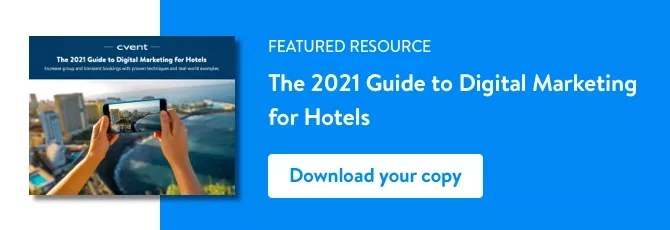If you’re currently working on digital marketing for your hotel, you know how important your hotel website is to the booking experience. Having eye-catching imagery, appropriate messaging, and a seamless experience can set you apart from your competition and increase the chances that your target audience will book. One important metric for measuring website performance as a sales tool is the look-to-book ratio. It’s an important measurement for any hotel, but it isn’t always used (or improved) strategically.
In this post, we take a deep dive into the look-to-book ratio. We explore what it is, what an average ratio looks like, how to improve it, and more.
What is look-to-book ratio?
It’s the percentage of people who book with you after viewing your property’s website. The term is an industry-specific version of the more general "conversion rate." Along with other important metrics, the look-to-book ratio can be used to see how effective your website is at converting viewers into customers.
What is an average look-to-book ratio?
Look-to-book ratio fluctuates based on a variety of factors, including hotel type. For example, a high-end luxury hotel with viral marketing and world-class amenities may have a worse look-to-book ratio due to virtual "window shopping." Meaning, users may be more likely to navigate to the site out of curiosity without the intention of actually booking. But, according to Forbes, mid-tier hotels usually hover around 2-7% (for every 100 website visitors, 2-7 of them become customers).
If your ratio falls below 2%, it’s a clue that something about your website experience may need to change. If, however, your rates are consistently higher than 5%, it could mean that you’ve found a message and website experience that resonates with your audience.
However, it can be hard to determine which searchers are genuine and which are bots or scraping programs. If you don’t have the ability to parse visitor data (and many hotels don’t), how can you meaningfully use look-to-book ratio? The answer lies in comparison. By comparing your ratio to other hotels in your location, travel type, and size category, you can tell whether your website is performing well as a sales tool and whether you need to improve it.
How can a hotel improve its look-to-book-ratio?
There are a few main factors that will affect your look-to-book ratio: website performance, messaging, search engine optimization, and booking engine experience. All of these factors can be improved and can contribute to an improved ratio.
1. Website performance
Your website’s speed, ease of navigation, and overall performance will have a huge impact on whether visitors stick around long enough to complete their bookings. Visitors are not known for their patience. According to Website Builder Expert, "You can think of site speed as a sliding scale, where the faster sites reap the most benefits, and every second makes a difference. For example, pages that load within two seconds have an average bounce rate of 9%, while pages that load in five seconds see their bounce rates skyrocket to 38%.”
This means that you’ll need to do everything you can to ensure your website loads fast and runs smoothly. Make sure all of your images are compressed and that your forms and tables are optimized for the device the visitor sees them on. Use Google’s free speed test to check how fast your website is loading and get tips for improving your site’s overall performance.
Let us help you grow your group business
2. Target audience and messaging
The customers who are most likely to book when they visit your website are the ones who are highly motivated to book a stay at a hotel like yours. Meaning, they have been actively searching for a property in your location, hotel type, and price category. It should come as no surprise that targeted paid advertising will bring these potential customers to your website and will typically result in a better look-to-book ratio. Consider investing in paid search, retargeting, and other channels for highly-motivated prospects to get those numbers up.
Whether you’re using paid search, organic content, or partnerships to bring visitors to your website, the messaging will need to be compelling once they get there. For this, you need the appropriate positioning for your target audience. Which customers do you serve best? What amenities and hotel features make you stand out from the crowd for those customers? How can you communicate this extra value on your website? Make sure your messaging is targeted to the specific groups you want to reach and clearly communicates the value you provide. This way, more customers will feel comfortable booking the first time they visit your site. Check out our guide to the 7 types of hotel guests and how to appeal to them for a deeper dive on this topic.
3. Search engine optimization
If you want to get the right traffic from organic search, you need to make sure your hotel is getting found by your target audience. And for that, you’ll need to prioritize search engine optimization (SEO). Make sure you're following technical SEO and other hotel SEO best practices to rank as high as possible for your chosen search terms. This includes using appropriate headers, having high-quality images with relevant alt text, updating your meta description and page titles, and having one “theme” for each page so that the messaging is highly targeted.
4. Booking engine experience
Last, but certainly not least, is the booking experience that your booking engine provides. Put simply: How easy is it for someone to book? Count the number of clicks involved in your process, as well as the number of fields that a user needs to fill in before making a booking. Consider whether every button click and form field is necessary, since each one will increase the friction in the process.
Give potential customers guidance on how to use your engine and what comes next by including effective calls-to-action. This is the text on your links and buttons that tells users what to expect when they click. By guiding people throughout the process you’ll make it easier for them to complete their bookings and boost your look-to-book ratio.
One final note to keep in mind as you implement changes to improve your look-to-book ratio: Improvements shouldn’t be in a vacuum. All the website changes you make won’t have any effect if you aren’t bringing the right traffic to your site. And great conversion rates aren’t helpful if they result in correspondingly high cancellation rates. Think of your conversions as one piece of the puzzle, and one step in a long customer journey. Keep all of the pieces of the customer journey in mind as you make your changes, and you’ll be much more likely to find a look-to-book ratio that works for you and your hotel.
Get started boosting your hotel's look-to-book ratio today!
Ready to take on more? Our complete digital marketing guide for hotels has all the information you need to improve your messaging and win customers online.






